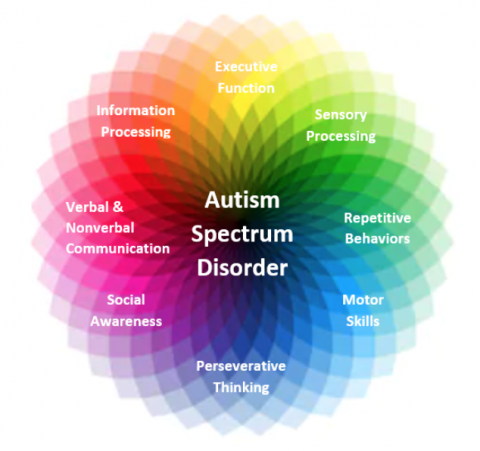Exploring Autism: Techniques for Efficient Interaction and Communication
Reliable interaction and interaction with individuals on the autism spectrum necessitate an extensive understanding of their distinct demands and choices. Strategies such as employing clear language, making use of visual assistances, and fostering consistent routines can considerably improve interaction and decrease anxiety. Furthermore, acknowledging the importance of non-verbal cues and shared rate of interests leads the way for meaningful connections. The intricacies of these approaches disclose more factors to consider that warrant exploration, particularly in how they can be adapted to private experiences and diverse contexts. What might these adaptations resemble in technique?
Understanding Autism Range Disorder
Autism Range Disorder (ASD) includes a range of neurodevelopmental problems characterized by obstacles in social interaction, interaction, and repeated behaviors. The term "spectrum" mirrors the diverse symptoms and differing degrees of extent experienced by individuals with ASD. While some might display significant disabilities, others may show high-functioning traits, enabling higher self-reliance in day-to-day live.
The beginning of ASD generally occurs in early childhood years, with signs usually well-known by age two. Very early indications may include postponed speech development, restricted eye call, and troubles in understanding social hints. Although the exact etiology of ASD continues to be vague, research suggests a combination of ecological and hereditary variables plays a critical function in its development.
As a result, treatments and support customized to individual requirements are essential for fostering interaction and social skills. Recognizing the complexity of ASD is important for promoting understanding, acceptance, and reliable strategies that assist in purposeful communications with individuals on the spectrum.

Relevance of Clear Interaction
Effective communication is essential for promoting understanding and link, particularly for people with Autism Spectrum Problem (ASD) Clear interaction not only assists in social interactions however also enhances the individual's capacity to reveal their demands, emotions, and ideas. For individuals with ASD, the subtleties of language can typically be testing; therefore, utilizing straightforward and unambiguous language is essential.
Furthermore, clear communication helps in reducing irritation and anxiousness that might arise from misconceptions. When messages are shared in a consistent and direct fashion, individuals with ASD are better equipped to translate info properly, which can considerably boost their social engagement and engagement in numerous setups.
Establishing regimens and using visual supports can additionally strengthen clear communication. These techniques give individuals with foreseeable frameworks that help comprehension and retention of information. In addition, proactively being and paying attention individual during interactions promotes a supportive setting where individuals with ASD really feel valued and recognized.
Inevitably, prioritizing clear communication not only encourages individuals with ASD yet also cultivates even more meaningful connections with their peers, caregivers, and the wider neighborhood, leading the way for collective partnerships and inclusive communications. - autism
Non-Verbal Interaction Strategies
Interaction expands past words, and for people with Autism Spectrum Condition (ASD), non-verbal cues he has a good point play a significant role in communications. Non-verbal interaction techniques can include facial expressions, gestures, body movement, and eye contact, all of which act as essential elements for communicating intents and emotions.
Recognizing and analyzing these non-verbal signals can boost communications with people with ASD. A cozy smile or open stance can create an inviting ambience, encouraging engagement. Using visual aids-- such as image cards or symbols-- can bridge interaction spaces and assist share messages more successfully.
It is also essential to be conscious of individual space, as individuals with ASD may have various comfort degrees concerning proximity. Observing their reactions to physical nearness can inform appropriate changes.

Creating Helpful Atmospheres
Producing an encouraging atmosphere is important for promoting positive interactions and enhancing the Visit Your URL well-being of individuals with Autism Spectrum Problem (ASD) Such settings can significantly decrease anxiousness and produce a sense of security, allowing people to share themselves more easily.
To attain this, it is necessary to think about sensory sensitivities that individuals with ASD might experience. Modifying the physical room to consist of soft lighting, marginal background sound, and comfy seating can produce a calming ambience. Furthermore, utilizing consistent regimens and clear aesthetic timetables can assist individuals prepare for changes and decrease unpredictability, more promoting comfort.
Social areas ought to be structured to minimize overwhelming stimulations while providing chances for interaction in preferred tasks. Facilitating areas designated for peaceful time can likewise function as a sanctuary throughout minutes of anxiety. Notably, integrating components of selection empowers individuals, allowing them to work out firm in their environment.

Urging Social Communications
Promoting social communications amongst individuals with Autism Range Problem (ASD) calls for willful approaches that prioritize comfort and interaction. Developing foreseeable regimens can aid decrease stress and anxiety, making social settings more approachable. Creating organized environments with specified obligations and functions permits people to involve without the overwhelming stress of unstructured social dynamics.
Including rate of interests and strengths right into social activities can act as a stimulant for communication. As an example, organizing team activities around shared leisure activities or topics of attraction can help with all-natural conversations and links. Additionally, utilizing aesthetic supports, such as social scripts or pictorial routines, can aid in recognizing social hints and expectations.
Modeling appropriate social habits is vital - autism. Peers and adults ought to demonstrate efficient interaction methods, consisting of energetic listening and turn-taking. Role-playing situations can likewise give a secure room for people to exercise these abilities
Lastly, fostering peer relationships through inclusive techniques is important. Encouraging comprehensive playdates or team getaways can develop possibilities for socialization in a comfortable setup. By executing these caretakers, approaches and educators can considerably boost social interactions for individuals with ASD, promoting their total social development and well-being.
Verdict
In verdict, reliable interaction and communication methods are crucial for sustaining individuals with Autism Range Condition. Emphasizing clear language, including non-verbal hints, and developing predictable regimens considerably enhance interaction and reduce stress and anxiety. Creating helpful environments cultivates safe social communications, while encouraging shared passions promotes significant links. Inevitably, these approaches equip people with autism to browse social landscapes, promoting their general well-being and allowing the growth of long lasting partnerships.
Efficient interaction and communication with individuals on the autism range require a comprehensive understanding of their distinct demands and choices. Clear interaction not just promotes social communications but additionally boosts the person's capacity to reveal their visit this site right here emotions, demands, and ideas.Cultivating social interactions amongst individuals with Autism Range Disorder (ASD) needs intentional approaches that focus on convenience and involvement. By applying these strategies, caretakers and instructors can dramatically boost social communications for people with ASD, promoting their general social advancement and wellness.
In final thought, efficient communication and interaction strategies are important for supporting individuals with Autism Spectrum Disorder.